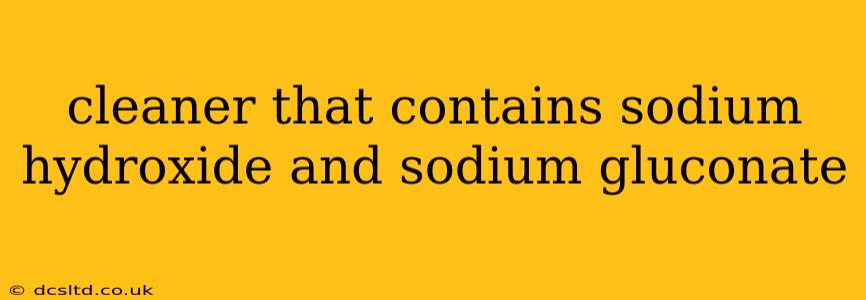Understanding Cleaners Containing Sodium Hydroxide and Sodium Gluconate
Many cleaning products utilize a combination of chemicals to achieve effective cleaning power. A common pairing is sodium hydroxide (NaOH), also known as lye or caustic soda, and sodium gluconate. Understanding the role of each ingredient helps clarify the cleaner's function and potential benefits and drawbacks.
What is Sodium Hydroxide (NaOH)?
Sodium hydroxide is a highly alkaline substance known for its potent cleaning abilities. It's effective at dissolving grease, oil, and other organic matter. Its strong alkalinity breaks down these substances, making them easier to remove. This makes it a key ingredient in many heavy-duty cleaners, including drain cleaners, oven cleaners, and degreasers. However, it's crucial to remember that sodium hydroxide is corrosive and requires careful handling. Always follow the manufacturer's instructions and wear appropriate safety gear, such as gloves and eye protection.
What is Sodium Gluconate?
Sodium gluconate is a chelating agent. This means it binds to metal ions, preventing them from interfering with the cleaning process. Hard water often contains minerals like calcium and magnesium, which can reduce the effectiveness of cleaning agents and leave behind unsightly residue. Sodium gluconate helps to counteract this by sequestering these metal ions, ensuring the cleaning solution works optimally even in hard water conditions. It also enhances the stability and performance of the overall cleaning formulation.
Why are Sodium Hydroxide and Sodium Gluconate Used Together?
The combination of sodium hydroxide and sodium gluconate offers several advantages:
- Enhanced Cleaning Power: Sodium hydroxide provides the powerful cleaning action, while sodium gluconate improves its efficiency, particularly in hard water.
- Improved Stability: Sodium gluconate helps to stabilize the sodium hydroxide solution, preventing premature degradation and maintaining its effectiveness over time.
- Reduced Residue: By chelating metal ions, sodium gluconate helps minimize the chances of mineral deposits being left behind after cleaning.
- Better Compatibility: The combination can improve the compatibility of the cleaner with various surfaces, reducing the risk of damage.
Frequently Asked Questions (PAA)
While specific questions under "People Also Ask" will vary based on search engine and current trends, here are some common questions related to cleaners containing sodium hydroxide and sodium gluconate that we can address:
Is a cleaner with sodium hydroxide and sodium gluconate safe for all surfaces?
No. While sodium gluconate improves compatibility, sodium hydroxide remains corrosive. Always test the cleaner on an inconspicuous area first before using it on a larger surface to avoid damage. This cleaner is generally not suitable for delicate surfaces like certain plastics or painted finishes.
What are the potential risks associated with using a cleaner containing sodium hydroxide?
Sodium hydroxide is a caustic substance that can cause skin irritation, burns, and eye damage. Always wear appropriate safety gear, including gloves and eye protection, when handling products containing this chemical. Ensure adequate ventilation to avoid inhalation of fumes. In case of contact with skin or eyes, immediately rinse with plenty of water and seek medical attention if necessary.
How do I dispose of a cleaner containing sodium hydroxide and sodium gluconate?
Proper disposal is crucial. Never pour the cleaner down the drain without checking local regulations. Contact your local waste management authority for guidance on the safe disposal of hazardous chemicals.
Are there any eco-friendly alternatives to cleaners containing sodium hydroxide?
Yes, many eco-friendly cleaning alternatives exist, often utilizing plant-based surfactants and enzymes. However, these alternatives may not offer the same powerful cleaning action as sodium hydroxide-based cleaners. The best choice depends on the specific cleaning task and environmental concerns.
This information is for educational purposes only. Always refer to the manufacturer's instructions and safety data sheets (SDS) for specific product information and handling precautions before using any cleaning product.
